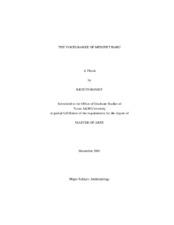| dc.description.abstract | The Sea Peoples are generally assumed to be a loose confederation of clans that first appeared in the historical record in the 14th century B.C.E. Over a century of scholarship has puzzled over whether they were responsible for the collapse of several Late Bronze Age civilizations or simply one of several catalysts that put that collapse in motion. Many attempts have also been made to determine the origins of the various groups of Sea Peoples using textual and iconographic evidence, as well as the material culture of the Sea Peoples identified in Cyprus and the Levant. This material culture is characterized foremost by locally made Mycenaean-style pottery; as such, a considerable Aegean or Mycenaean presence has been argued in the multi-ethnic Sea Peoples coalition.
The most important visual record that survives of the Sea People documents a land and sea battle against the forces of Ramesses III in the early 12th century B.C.E. and is recorded on the walls of the pharaoh's mortuary temple at Medinet Habu. In 1964 a connection was first proposed between the distinctive ships of the Sea Peoples in the Medinet Habu naval battle relief, with their high, angular stem- and stern- posts topped with outward-facing water-bird heads, and the vogelbarke, or bird-boat, of Late Bronze Age Central European religious iconography. Too little is still understood of both the vogelbarke tradition and the maritime abilities of Bronze Age Central European populations to conclusively state at this time that a vogelbarke-like vessel could have plied the waters of the eastern Mediterranean during the Late Bronze Age. However, additional archaeological evidence suggests a Central European mercenary presence in Mycenaean Greece during the period of Sea Peoples activity, as well as Central European participation in the multi-ethnic coalition reflected particularly in the material culture of the Sea Peoples identified in Cyprus. This evidence strengthens the possibility that the vogelbarke-like vessel some scholars claim to see at Medinet Habu is indeed not a "duck out of water." | en |


